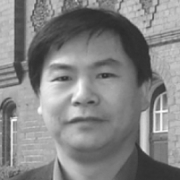
Prof Huajiang Ouyang PhD
Professor Mechanical and Aerospace Engineering
- Work email H.Ouyang@liverpool.ac.uk
- About
- Research
- Publications
- Teaching
- Professional Activities
Research
Structural Dynamics and Control
Friction-induced vibration (general nonlinear vibration, brake squeal and other brake noise, turning chatter):
Friction is everywhere. It is usually a source of energy dissipation, but sometimes can cause vibration. The latter includes brake squeal, squeaky hinges, machining chatter, etc. Friction also causes wear and heat conduction. Contact must be considered in friction-induced vibration. This remains a challenging and interesting research subject. TRW Automotive and Jaguar Land Rover are two sponsors of this research topic of mine.
Moving-load dynamic problems (vehicle-track-bridge dynamic interaction, spinning discs, turning chatter):
Most loads are fixed in space but some loads are in relative motion to the structures, for example, a train crosses a bridge and runs through a tunnel, a computer spins past a reader/writer head. Moving loads make a structure gain time-varying mass, stiffness and damping. Analysis of moving-load induced vibration is computationally intensive and its control is difficult. EPSRC has sponsored two project on mine on this topic.
Parametric and nonlinear vibration.
Friction-induced vibration and moving-load induced vibration all belong to parametric vibration. If the law of friction is of a nonsmooth Coulomb type, the vibration is highly nonlinear. Stick-slip vibration and loss of contact can also take place. This kind of vibration is numerically challenging.
Vibration control via eigenstructure assignment:
Vibration reduction (or magnification) can effectively be realised by assigning frequencies/mode to a structure/machine. Various work done includes: passive and active assignment of frequencies and modes, passive partial assignment, pole assignment for stabilising friction-induced vibration.
Vibration-based Structural Identification
Vibration is often used as a way of identifying structural properties. A theoretical model can be corrected via model updating based on measure vibration data. Structural damage can be identified too. Of particular interest are identification of welded joints and bolted joints in assembled structures. These topics belong to challenging inverse dynamics.
Rotor Dynamics
Rotating machines are prone to vibration. Research is going on in passive and active assignment of frequencies and modes to rotating machines for vibration control.
Research Grants
Vibration control and fault detection of complicated systems/structures
ROYAL SOCIETY (CHARITABLE)
April 2006 - March 2008
Moving-load distributions in structural dynamics.
ENGINEERING & PHYSICAL SCIENCES RESEARCH COUNCIL
June 2006 - May 2009
Linux cluster for structural dynamics research.
ENGINEERING & PHYSICAL SCIENCES RESEARCH COUNCIL
October 2004 - September 2007
A New Approach to Vibration Mitigation of Moving-load Problems
ENGINEERING & PHYSICAL SCIENCES RESEARCH COUNCIL
February 2010 - April 2013
Factor 20: reducing CO2 emissions from inland transport by a major modal shift to rail.
ENGINEERING & PHYSICAL SCIENCES RESEARCH COUNCIL
January 2010 - April 2011
Inverse methods for vibration suppression using structural modifications.
ENGINEERING & PHYSICAL SCIENCES RESEARCH COUNCIL
October 2001 - September 2004
Frame-structure vibration with joint friction.
ENGINEERING & PHYSICAL SCIENCES RESEARCH COUNCIL
October 2000 - September 2003
Research Collaborations
Drs Maryam Ghandchi-Tehrani and Yeping Xiong
External: University of Southampton
Dr Marko Tirovic
External: University of Cranfield
brake squeal
Dr Nurulakmar Abu Husain
External: Universiti Teknologi Malaysia
Professors Xinglin Guo and Yahui Zhang
External: Dalian University of Technology
Professor Andrew Day
External: University of Bradford
brake squeal
Professor Jonathan E Cooper
External: The University of Bristol
Professors Zichen Deng and Weipeng Hu, Mr Kai Zhang
External: Northwestern Polytechnical University, China
Professor Kumar Vikram Singh
External: University of Miami
Professors Alberto Trevisani and Dario Richiedei
External: University of Padua
Dr Gabriele Zanardo
External: Johannes Kepler University
Professor Hongyan Wang, Dr Qiang Rui
External: Beijing Institute of Technology
Professor Luis Baeza
External: Universidad Politécnica de Valencia
Dr Fadlur R M Romlay
External: Universiti Malaysia Pahang
Professors Guangxiong Chen, Zhongrong Zhou, Xinsong Jin, Minhao Zhu
External: Southwest Jiaotong University, China
Professor Hongwu Zhang, Mrs Congmin Niu
External: Dalian University of Technology
jointly supervising a PhD student working of vibration and control of cranes
Professor Minjie Wang, Mr Xianguo Han
External: Dalian University of Technology
research collaboration on vibration in turning operations and have joint papers
Professor HU Shaolin
External: Xi'an Jiaotong University
sponsored by the Royal Society of UK and Natural Science Foundation of China
Dr Abdul Rahim Abu Bakar
External: Universiti Teknologi Malaysia
joint research and journal and conference papers
Structural Mechanics
Internal
research into vibration of atomising discs
Dr Yongbin Yuan
External: TRW Automotive
have joint conference and journal papers
Dr Wane Nack
External: General Motor Corporation
have joint journal and conference papers
Dr Frank Chen
External: Ford Motor Company
have joint publications in conference and journal papers and in a book
Professors Yuanxian Gu and Haitian Yang
External: Dalian University of Technology
have had joint publications
Dr Torsten Treyde
External: TRW Automotive
joint research and journal and conference papers, and have grants from TRW
Professor Matthew P Cartmell
External: The University of Glasgow
have had joint publications
Professor Michael I Friswell
External: The University of Bristol
have had joint publications
Dynamics/Professor J E Mottershead
Internal
have had joint publications and grants
have jointly supervised MSc and PhD students